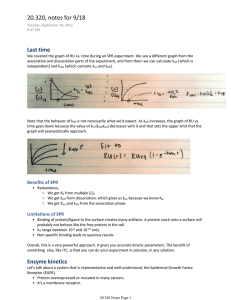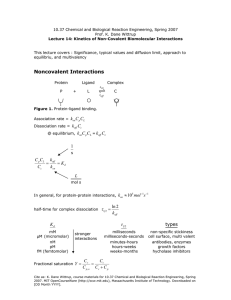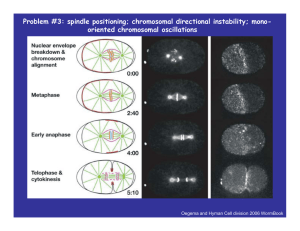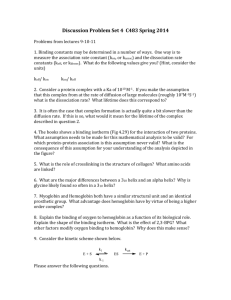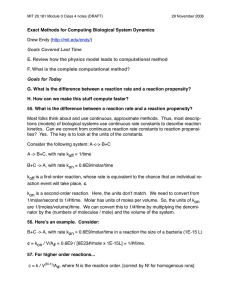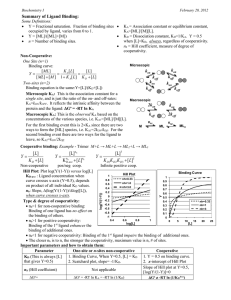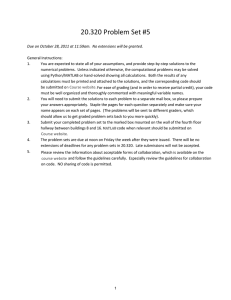Optimal target search on a fast folding polymer chain with volume
advertisement
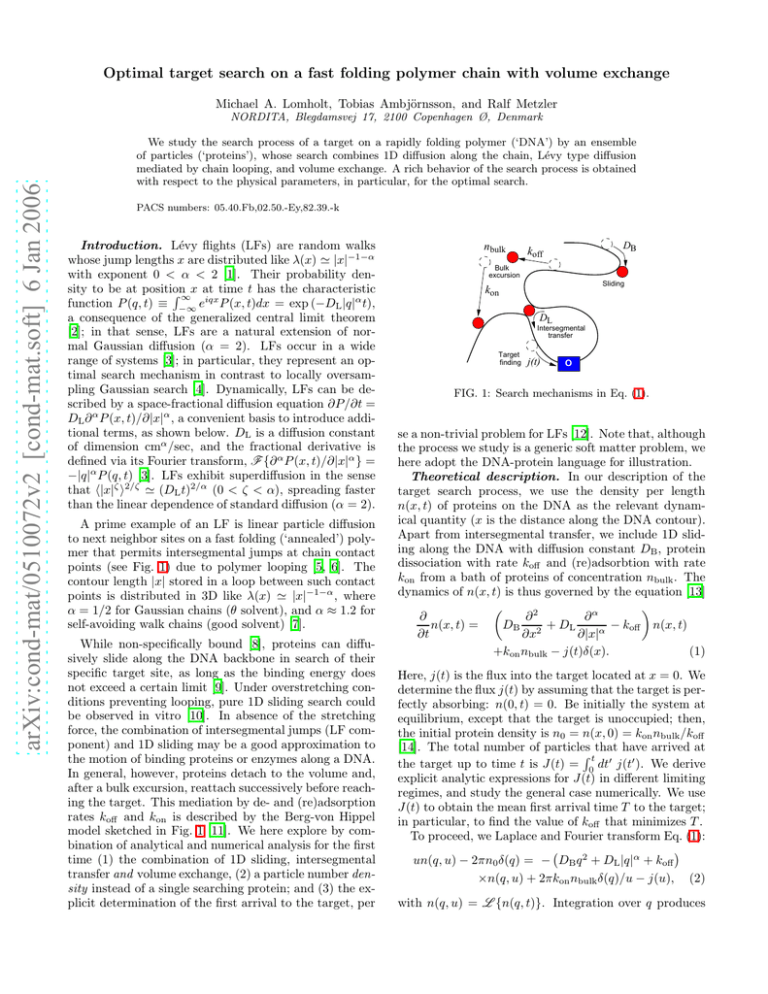
Optimal target search on a fast folding polymer chain with volume exchange
Michael A. Lomholt, Tobias Ambjörnsson, and Ralf Metzler
arXiv:cond-mat/0510072v2 [cond-mat.soft] 6 Jan 2006
NORDITA, Blegdamsvej 17, 2100 Copenhagen Ø, Denmark
We study the search process of a target on a rapidly folding polymer (‘DNA’) by an ensemble
of particles (‘proteins’), whose search combines 1D diffusion along the chain, Lévy type diffusion
mediated by chain looping, and volume exchange. A rich behavior of the search process is obtained
with respect to the physical parameters, in particular, for the optimal search.
PACS numbers: 05.40.Fb,02.50.-Ey,82.39.-k
Introduction. Lévy flights (LFs) are random walks
whose jump lengths x are distributed like λ(x) ≃ |x|−1−α
with exponent 0 < α < 2 [1]. Their probability density to be at position
R ∞x at time t has the characteristic
function P (q, t) ≡ −∞ eiqx P (x, t)dx = exp (−DL |q|α t),
a consequence of the generalized central limit theorem
[2]; in that sense, LFs are a natural extension of normal Gaussian diffusion (α = 2). LFs occur in a wide
range of systems [3]; in particular, they represent an optimal search mechanism in contrast to locally oversampling Gaussian search [4]. Dynamically, LFs can be described by a space-fractional diffusion equation ∂P/∂t =
DL ∂ α P (x, t)/∂|x|α , a convenient basis to introduce additional terms, as shown below. DL is a diffusion constant
of dimension cmα /sec, and the fractional derivative is
defined via its Fourier transform, F {∂ α P (x, t)/∂|x|α } =
−|q|α P (q, t) [3]. LFs exhibit superdiffusion in the sense
that h|x|ζ i2/ζ ≃ (DL t)2/α (0 < ζ < α), spreading faster
than the linear dependence of standard diffusion (α = 2).
A prime example of an LF is linear particle diffusion
to next neighbor sites on a fast folding (‘annealed’) polymer that permits intersegmental jumps at chain contact
points (see Fig. 1) due to polymer looping [5, 6]. The
contour length |x| stored in a loop between such contact
points is distributed in 3D like λ(x) ≃ |x|−1−α , where
α = 1/2 for Gaussian chains (θ solvent), and α ≈ 1.2 for
self-avoiding walk chains (good solvent) [7].
While non-specifically bound [8], proteins can diffusively slide along the DNA backbone in search of their
specific target site, as long as the binding energy does
not exceed a certain limit [9]. Under overstretching conditions preventing looping, pure 1D sliding search could
be observed in vitro [10]. In absence of the stretching
force, the combination of intersegmental jumps (LF component) and 1D sliding may be a good approximation to
the motion of binding proteins or enzymes along a DNA.
In general, however, proteins detach to the volume and,
after a bulk excursion, reattach successively before reaching the target. This mediation by de- and (re)adsorption
rates koff and kon is described by the Berg-von Hippel
model sketched in Fig. 1 [11]. We here explore by combination of analytical and numerical analysis for the first
time (1) the combination of 1D sliding, intersegmental
transfer and volume exchange, (2) a particle number density instead of a single searching protein; and (3) the explicit determination of the first arrival to the target, per
n bulk
DB
koff
Bulk
excursion
Sliding
kon
DL
Intersegmental
transfer
Target
finding
j(t)
O
FIG. 1: Search mechanisms in Eq. (1).
se a non-trivial problem for LFs [12]. Note that, although
the process we study is a generic soft matter problem, we
here adopt the DNA-protein language for illustration.
Theoretical description. In our description of the
target search process, we use the density per length
n(x, t) of proteins on the DNA as the relevant dynamical quantity (x is the distance along the DNA contour).
Apart from intersegmental transfer, we include 1D sliding along the DNA with diffusion constant DB , protein
dissociation with rate koff and (re)adsorbtion with rate
kon from a bath of proteins of concentration nbulk . The
dynamics of n(x, t) is thus governed by the equation [13]
∂
∂α
∂2
− koff n(x, t)
n(x, t) =
DB 2 + DL
∂t
∂x
∂|x|α
+kon nbulk − j(t)δ(x).
(1)
Here, j(t) is the flux into the target located at x = 0. We
determine the flux j(t) by assuming that the target is perfectly absorbing: n(0, t) = 0. Be initially the system at
equilibrium, except that the target is unoccupied; then,
the initial protein density is n0 = n(x, 0) = kon nbulk /koff
[14]. The total number of particles that have arrived at
Rt
the target up to time t is J(t) = 0 dt′ j(t′ ). We derive
explicit analytic expressions for J(t) in different limiting
regimes, and study the general case numerically. We use
J(t) to obtain the mean first arrival time T to the target;
in particular, to find the value of koff that minimizes T .
To proceed, we Laplace and Fourier transform Eq. (1):
un(q, u) − 2πn0 δ(q) = − DB q 2 + DL |q|α + koff
×n(q, u) + 2πkon nbulk δ(q)/u − j(u), (2)
with n(q, u) = L {n(q, t)}. Integration over q produces
2
10000
100
From these limits, we now infer the behavior of J(t),
based on Tauberian theorems stating that J(t) at t → 0
is determined by J(u) at u → ∞, and vice versa [1]. We
discover a rich variety of domains, compare Tab. I:
(1.) Sliding search: Desorption from the DNA can be
−1
neglected for times t ≪ koff
. If also t ≪ τBL , Eq. (5)
with koff = 0 by inverse Laplace transform leads to
Numerical solution, α=3/2
Sliding search, α=3/2
Interr. Levy search, α=3/2
Fussy Levy search, α=3/2
Numerical solution, α=1/2
Sliding search, α=1/2
Sloppy Levy search, α=1/2
J(t)
1
n0=250 (koff)1/2/(DB)1/2
τBL=10-5(koff)-1
0.01
1/γ1
J(t) ∼ (t/τ1 )γ1 , γ1 = 1/2, τ1 = π/(16DB n0
n0=(koff)1/2/(DB)1/2
τBL=10-9(koff)-1
(8)
In this regime, only the 1D sliding mechanism matters.
−1
(2.) Fussy Lévy search: For τBL ≪ t ≪ koff
(α > 1),
the LF dominates the flux into the target; from Eq. (6),
1e-04
1e-06
1e-12
).
1e-10
1e-08
1e-06
1e-04
0.01
1
100
koff t
1/γ2
J(t) ∼ (t/τ2 )γ2 , γ2 = 1/α, τ2 = C2 /(DL n0
FIG. 2: Number of proteins arrived at the target up to t.
Numerical solutions of Eq. (3) and limiting regimes.
J(u) = j(u)/u = n0 / u2 W0 (u) due
R to the perfect absorption condition n(0, u) = (2π)−1 dq n(q, u) = 0. Or,
Rt
0
dt′ W0 (t − t′ )J(t′ ) = n0 t
(3)
in the t-domain. Eq. (3) is a Volterra integral equation
of the first kind, whose kernel W0 is read off Eq. (2):
Z ∞
dq
1
W0 (u) =
, (4)
2
α
−∞ 2π DB q + DL |q| + koff + u
that is the Laplace transform of the Green’s function
of n(x, t) at x R= 0. Back-transforming, we obtain
∞
W0 (t) = (2π)−1 −∞ dq exp −(DB q 2 + DL |q|α + koff )t ,
which has a singularity at t = 0. Eq. (3) can be solved
numerically by approximating J(t) by a piecewise linear
function, converting the integral equation to a linear set
of equations. Typical plots are shown in Fig. 2.
−1
Eq. (4) reveals only two relevant time scales: koff
and
α
2 1/(2−α)
τBL = (DB /DL )
. We now obtain asymptotic re−1
sults for small and large (koff + u), compared to τBL
.
−1
koff +u ≫ τBL : In this limit, the denominator of the integrand in Eq. (4) is dominated either by the term DB q 2
or by koff + u for any q; we find the approximation [15]
−1/2
W0 (u) ∼ W0 (u)|DL =0 = [DB (koff + u)]
/2 .
(5)
−1
koff + u ≪ τBL
and α > 1 (‘connected LFs’): Here, a
singularity exists at small q as koff + u → 0. For finite
but small koff + u → 0, the integrand is dominated by
the DL |q|α term compared to DB q 2 at small q, yielding
i−1
h
1/α
.
(6)
W0 (u) ∼ α sin(π/α)DL (koff + u)1−1/α
−1
koff + u ≪ τBL
and α< 1 (‘disconnected LFs’): Now,
the singularity is weak, and the integral becomes
−1
q
1−α
−1
W0 (u) ∼ (2 − α) sin
π
.
(7)
DB τBL
2−α
),
(9)
where C2 = {Γ(1 + 1/α)/[α sin(π/α)]}α . Now, LFs are
the overall dominating mechanism. This contrasts:
(3.) Sloppy Lévy search: For α < 1, t ≫ τBL , and
−1
koff
≫ τBL , we obtain from Eq. (7)
J(t) ∼
t
τ3
γ3
α/[2(2−α)]−1/2
, γ3 = 1, τ3 = C3
DB
1/(2−α) 1/γ3
n0
DL
, (10)
−1
and C3 = {(2 − α) sin([1
R − α]π/[2 − α])} . For α <
1, even the step length dx |x|λ(x) diverges, making it
impossible for the protein to hit a small target solely by
LF, and local sampling by 1D sliding becomes vital. At
longer times, volume exchange mediated by koff enters:
(4.) Interrupted Lévy search: For α > 1 and t ≫
−1
koff
≫ τBL we can ignore u in Eq. (6), yielding
1/α 1−1/α 1/γ4
n0 ),
J(t) ∼ (t/τ4 )γ4 , γ4 = 1, τ4 = C4 /(DL koff
(11)
with C4 = 1/[α sin(π/α)]. The search on the DNA is
dominated by LFs, interrupted by 3D volume excursions.
−1
(5.) Interrupted sliding search: If τBL ≫ koff
, LFs will
not contribute at any t. Instead we find from Eq. (5)
γ5
J(t) ∼ (t/τ5 )
1/2 1/2 1/γ5
, γ5 = 1, τ5 = 1/(2DB koff n0
) (12)
−1
for t ≫ koff
. This is sliding-dominated search with 3D
excursions. There exist three scaling regimes for 1 < α <
2, and two for 0 < α < 1; see Fig. 2 and Tab. I.
−1
We found that the relevant time scales koff
and τBL
together with α give rise to 5 basic search regimes, each
characterized by an exponent γi and characteristic time
scale τi . In particular, we saw that J(t) ∼ (t/τi )γi ,
where the exponent γi 6= 1 for the first two regimes
(i = 1, 2); in the other cases, we have γi = 1. The
stable index α characterizing the polymer statistics thus
strongly influences the overall search. Also note that
−1
J(t) ≃ t when t ≫ koff
, or t ≫ τBL and α < 1. The
characteristic time scales τi , since J(t) ≃ n0 , scale like
R∞
−1/γ
τi ≃ n0 i . As any integral I = 0 dtf (t/τi ) can be
R∞
transformed by s ≡ t/τi to I = τi 0 dsf (s), it is I ≃ τi .
Thus, we find that the mean first arrival time scales like
3
1
= 3=2, Eq. (14)
= 3=4, Eq. (14)
= 1=4, Eq. (14)
= 3=4, Eq. (16)
= 1=4, Eq. (17)
0.9
0.8
0.7
0.6
opt 0
=kon
ko
Regime
0<α<1 1<α<2
J ∼ (t/τi )γi
−1
t ≪ {τBL , koff }
Sliding
Sliding
γ1 = 1/2
−1
τBL ≪ t ≪ koff Sloppy Lévy Fussy Lévy γ3 = 1 | γ2 = α−1
−1
τBL ≪ koff
≪ t Sloppy Lévy Int. Lévy γ3 = 1 | γ4 = 1
−1
{t, τBL } ≫ koff
Int. Sliding Int. Sliding
γ5 = 1
0.5
TABLE I: Summary of search regimes. See text.
0.4
0.3
PSfrag replaements
R∞
−1/γ
n0 i
(see beT = τi 0 ds exp(−sγi ) = τi Γ(1/γi )/γi ≃
low) whenever a single of the five regimes dominates the
integral. In particular, the variation of T −1 with the line
density n0 ranges from quadratic (1D sliding) over nα
0 in
the fussy Lévy regime (1 < α < 2) to linear, the latter
being shared by sloppy Lévy and bulk mediated search.
Note that if 1D sliding is the sole prevalent mechanism,
we recover the result T = π/[8DB n20 ] of Ref. [10].
Optimal search. We now address the optimal search
of the target, i.e., which koff minimizes the mean first
arrival time T when DB , DL , kon , the DNA length L,
and the total amount of proteins are fixed. To quantify
the latter, we define lDNA ≡ L/V , where V is the system volume. The overall protein volume density is then
ntotal = lDNA n0 + nbulk . With the equilibrium condition
′
koff n0 = kon nbulk , this yields n0 = ntotal kon / (koff + kon
)
′
and a corresponding expression for nbulk ; here, kon
=
kon lDNA is the inverse average time a single protein
spends in the bulk solvent before (re)binding to the DNA.
To extract the mean first arrival time T , we reason as
follows (compare Ref. [10]): The total number of proteins
that have arrived at the target between t′ = 0 and t is
J(t). If N is the overall number of proteins, the probability for an individual protein to have arrived at the target
is J(t)/N . In the limit of large N , we obtain the survival
probability of the target (no protein has arrived) as
Psurv (t) = lim (1 − J(t)/N )
N →∞
N
= exp [−J(t)] ,
(13)
R∞
and thus T = 0 dt Psurv (t). Note that for LFs, the first
arrival is crucially different from the first passage [12].
The optimization is complicated by the exponential
function in Eq. (13). However, both in vitro and in vivo,
ntotal (and hence n0 ) is in many cases sufficiently small,
such that the relevant regime is J(t) ∝ t (i.e., we can approximate W0 (u) by W0 (u = 0)). The mean first arrival
time in this linear regime becomes
′
′
T = W0 (u = 0)[(koff + kon
)/kon
][lDNA /ntotal ].
(14)
opt
We observe a tradeoff in the optimal value koff
, that min′
′
imizes T : The fraction kon /(koff + kon ) of bound proteins
shrinks with increasing koff , increasing T . Counteracting
is the decrease of W0 (u = 0) (and T ) with growing koff .
Numerical solutions to the optimal search are shown
in Fig. 3 for different α. Three different regimes emerge:
α/2 ′ 1−α/2
(i) Without LFs (DL → 0 or DL ≪ DB (kon
)
),
opt
′
from Eq. (5) with W0 at u = 0, we obtain koff
= kon
:
the proteins should spend equal amounts of time in bulk
0.2
0.1
0 −2
10
−1
10
0
1
2
10 =2 0(1 =2) 10
DL=(DB kon
)
10
FIG. 3: Optimal choice of off rate koff as function of the LF
diffusion constant, from numerical evaluation of Eq. (14). The
opt
circle on the abscissa marks where koff
becomes 0 (Eq. (17)).
and on the DNA. This corresponds to the result obtained
for single protein searching on a long DNA [9, 16]. Two
additional regimes unfold for strong LF search, DL → ∞:
(ii) For α > 1, where Eq. (6) applies, we find
opt
′
koff
∼ (α − 1)kon
:
(15)
The optimal off rate shrinks linearly with decreasing α.
opt
(iii) For α < 1, the value of koff
approaches zero as
DL → ∞: The sloppy LF mechanism becomes so efficient
that bulk excursions become irrelevant. More precisely,
for 1/2 < α < 1 as DL goes to infinity,
opt
koff
∼
(2 − α)(1 − α) sin
α2 sin
2α−1
α π
1−α
2−α π
α
2α−1
1/α−1
′
kon
τBL
(16)
At α = 1/2, we observe a qualitative change: When α <
opt
1/2, the rate koff
reaches zero for all finite DL satisfying
−1
τBL
≥
(1 + α) sin ([1 − α]π/[2 − α]) ′
k .
(2 − α) sin ([1 − 2α]π/[2 − α]) on
(17)
Note that when α < 1, the spread of the LF (≃ t1/α )
grows faster than the number of sites visited (≃ t),
rendering the mixing effect of bulk excursions insignificant. A scaling argument to understand the crossover
at α = 1/2 relates the probability density of first arrival
with the width (≃ t1/α ) of the Green’s function of an
LF, pfa ≃ t−1/α . The associated mean arrival time becomes finite for 0 < α < 1/2, even for the infinite chain
considered here.
Discussion. Eq. (1) phrases the target search problem as a fractional diffusion-reaction equation with point
sink. This formulation pays tribute to the fact that for
LFs, the first arrival differs from the first passage: With
the long-tailed λ(x) of an LF, the particle can repeatedly
jump across the target without hitting, the first arrival
becoming less efficient than the first passage [12].
4
A borderline role is played by the Cauchy case α = 1,
separating connected (mean jump length h|x|i exists) and
disconnected LFs. For α < 1, the number of visited sites
grows slower than the width of the search region and
the LF mimics the uncorrelated jumps of bulk excursion;
the latter becomes obsolete for high LF diffusivity DL .
Below α = 1/2, bulk excursions already for finite DL
are undesirable. A similar observation can be made for
the scaling of the mean search time T with the Lévy
diffusivity DL , that is proportional to the rate an LF is
performed: For α > 1 in the interrupted Lévy search,
−1/(2−α)
−1/α
in the sloppy Lévy
, whereas T ≃ DL
T ≃ DL
search, where α < 1. The Lévy component is thus taken
most profit of when α approaches 1. Generally, too short
jumps, leading to local oversampling, as well as too long
jumps, missing the target, are unfavorable.
A crucial assumption of the model, analogous to the
derivation in Ref. [6], is that on the time scale of the diffusion process the polymer chain appears annealed; otherwise, individual jumps are no longer uncorrelated [5].
Generally, for proteins DB is fairly low, and can be further lowered by adjusting the salt condition, so that the
conditions for the annealed case can be met. Conversely,
by increasing DB in respect to the polymer dynamics,
leading to a higher probability to use the same loopinginduced ‘shortcut’ repeatedly, it might be possible to investigate the turnover from LF motion to ‘paradoxical
diffusion’ of the quenched polymer case [5].
Single molecule studies can probe the dynamics of the
target search and the quantitative predictions of our
model [10, 17]. Monitoring the target finding dynam-
ics may also be a novel way of investigating soft matter
properties regarding both polymer equilibrium configurations, giving rise to α, and its dynamics. With respect
to the first arrival properties, it would be interesting to
study the gradual change of the polymer properties from
self-avoiding behavior in a good solvent to Gaussian chain
statistics under θ or dense conditions.
[1] B. D. Hughes Random Walks and Random Environments
(Oxford University Press, Oxford, 1995), Vol. 1.
[2] P. Lévy, Théorie de l’addition des variables aléatoires
(Gauthier-Villars, Paris, 1954).
[3] R. Metzler and J. Klafter, Phys. Rep. 339, 1 (2000); J.
Phys. A 37, R161 (2004).
[4] G. M. Viswanathan et al., Nature 401, 911 (1999).
[5] I. M. Sokolov, J. Mai and A. Blumen, Phys. Rev. Lett.
79, 857 (1997).
[6] D. Brockmann and T. Geisel, Phys. Rev. Lett. 91, 048303
(2003).
[7] B. Duplantier, J. Stat. Phys. 54, 581 (1989).
[8] A. Bakk and R. Metzler, FEBS Lett. 563, 66 (2004); J.
Theor. Biol. 231, 525 (2004), and references. therein.
[9] M. Slutsky and L. A. Mirny, Biophys. J. 87, 4021 (2004).
[10] I. M. Sokolov, R. Metzler, K. Pant, and M. C. Williams,
Biophys. J. 89, 895 (2005); Phys. Rev. E 72, 041102
(2005).
[11] O. G. Berg, R. B. Winter, and P. H. von Hippel, Biochem.
20, 6929 (1981).
[12] A. V. Chechkin et al., J. Phys. A 36, L537 (2003).
[13] For identical proteins, their mutual avoidance is actually
included in Eq. (1), as on encounter it does not matter
whether they deflect each other or swap identities.
Note that the dimension of the on and off rates differ;
while [koff ] = sec−1 , we chose [kon ] = cm2 /sec.
The symbol ∼ implies that the relative difference vanishes, e.g.: limkoff +u→∞ W0 (u)|DL =0 /W0 (u) = 1.
M. Coppey, O. Bénichou, R. Voituriez, and M. Moreau,
Biophys. J. 87, 1640 (2004).
R. Metzler and T. Ambjörnsson, J. Comp. Theor.
Nanoscience 2, 389 (2005), and references therein.
J. Yan and J. F. Marko, Phys. Rev. Lett. 93, 108108
(2004).
T. Ambjörnsson and R. Metzler, Phys. Rev. E 72,
030901(R) (2005); S. K. Banik, T. Ambjörnsson, and R.
Metzler, Europhys. Lett. 71, 852 (2005).
−1
For α = 1 and koff + u ≪ τBL
we find W0 (u) ∼
−1
−1
(πDL ) log {1/[τBL (u + koff )]}. At koff
≫ t ≫ τBL ,
Tauberian theorems [1] lead to the logarithmic correction
J(t) ∼ t/[τ6 log(t/τBL )], with τ6 = 1/(πn0 DL ), while for
−1
t ≫ koff
≫ τBL , we have J(t) ∼ t/[τ6 log{1/(τBL koff )}].
In a next step, it will be of interest to explore effects
on the DNA looping behavior due to (a) the occurrence
of local denaturation bubbles performing as hinges [18],
whose dynamics can be understood from statistical approaches [19]; or (b) kinks imprinted on the DNA locally
by binding proteins. In the presence of different protein
species, the first arrival method may provide a way to
probe protein crowding effects to expand existing models
toward the in vivo situation.
Conclusion. Our search model reveals rich behavior
in dependence of the LF diffusivity DL and exponent α.
In particular, we found two crossovers for the optimal
search that we expect to be accessible experimentally. In
that sense, our model system is richer than the 2D albatross search model [4]. We note that in the Cauchy
case α = 1 additional logarithmic contributions are superimposed to the power laws [20]. Moreover, long-time
memory effects may occur in the process; in the protein
search, e.g., there are indications that both the sliding
search through stronger protein-DNA interactions [9] and
the volume diffusion through crowding effects are subdiffusive [3].
We thank I. M. Sokolov and U. Gerland for discussions.
[14]
[15]
[16]
[17]
[18]
[19]
[20]
